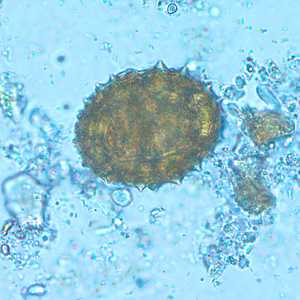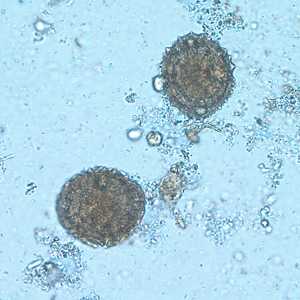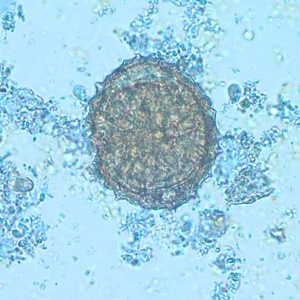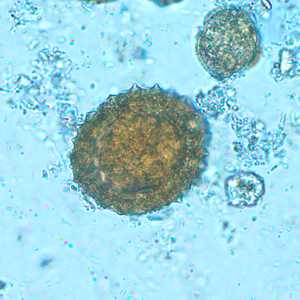
Case #216 - November, 2007
An asymptomatic, 35-year-old male with no known travel history went to his physician at a wellness clinic for a routine examination. An ova and parasite (O & P) examination was performed as part of the laboratory work-up at the State Health Laboratory. Unusual objects were observed in the formalin-concentrated stool, and the specimen was sent to CDC for diagnostic assistance and possible identification. Figures A-D were captured from wet mounts of the specimen. The objects measured approximately 50 micrometers by 42.5 micrometers. What is your diagnosis? Based on what criteria?

Figure A

Figure B

Figure C

Figure D
Case Answer
The objects were artifacts, most likely pollen grains, and a diagnosis was made of No Parasites Found (NPF). They closely resemble the fertile eggs of Ascaris lumbricoides. However, the size was not consistent with A. lumbricoides eggs (usually 55-75 micrometers by 35-50 micrometers) and the objects had pointed spines on the exterior, whereas fertile A. lumbricoides eggs have rounded mamillations.
More on: Artifacts
This case was kindly contributed by the Washington State Public Health Laboratories.
Images presented in the monthly case studies are from specimens submitted for diagnosis or archiving. On rare occasions, clinical histories given may be partly fictitious.
DPDx is an education resource designed for health professionals and laboratory scientists. For an overview including prevention and control visit www.cdc.gov/parasites/.
- Page last reviewed: August 24, 2016
- Page last updated: August 24, 2016
- Content source:
- Global Health – Division of Parasitic Diseases and Malaria
- Notice: Linking to a non-federal site does not constitute an endorsement by HHS, CDC or any of its employees of the sponsors or the information and products presented on the site.
- Maintained By:


 ShareCompartir
ShareCompartir